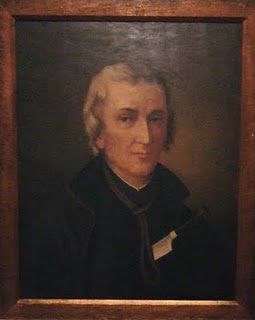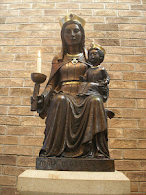
One of nine children, David Henry Lewis was born in 1616 in Abergavenny, Monmouthshire. His parents were Morgan Lewis and Margaret Pritchard. Morgan Lewis, a Protestant, was headmaster of King Henry VIII Grammar School in the town. Margaret Pritchard was a devout Catholic and she brought up eight of their children as Catholics but Morgan saw to it that their son David was brought up in the Protestant religion. Until the age of sixteen, David was educated at the local grammar school where his father was headmaster. He then went to London to study law.
It was while David was studying in London that he went on a visit to Paris. During this time in Paris he became a Catholic. In 1636, the young man returned to Abergavenny and lived with his parents until their deaths in 1638. Fr Charles Brown S J (vere Charles Gwynne) was then the Jesuit Superior of Wales and the other counties which came under the mission of St Francis Xavier. It was under the patronage of Fr Brown that David Lewis set off, in August 1638, for the English College in Rome. Upon his entrance to the College in November of that year, he assumed the name of Charles Baker. The College Diary notes, “Charles Baker, vere David Lewis, a South Welshman of the County of Monmouth was admitted as an alumnus November 6th 1638”. Because of the perilous conditions existing under the anti-Catholic Penal Laws in England at that time, it was common practise for those destined for the English Mission to assume an alias. David was ordained priest on 20th July 1642 and in April 1645 he entered the Jesuit novitiate of Sant’ Andrea in Rome. The newly professed Jesuit was sent back to Wales but he was quickly recalled to Rome to take up a position at his alma mater. However, 1648 saw the return of Fr David Lewis S J to Wales and to the Jesuit mission of St Francis Xavier at the Cwm, near Llanrothal. Here he would spend the rest of his life ministering in the area of Monmouth and the Welsh marches.
It was a dangerous time for Catholics in general but for priests in particular. Many of the authorities in Wales turned a blind eye to their Catholic friends, neighbours, and in some cases, family members, who clung to “The Old Faith”. Nonetheless, the priests had to work in secret, mainly at night. The administrative centre for the area was at the College of St Francis Xavier at the Cwm. Fr David Lewis served two periods as Superior, from 1667 – 1672 and then again from 1674 – 1678.
When the Oates Plot, the preposterous invention of the fetid mind of Titus Oates, engulfed the country in the autumn of 1678, there were about six priests at the Cwm, including the Superior, Fr David Lewis, his good friend Fr Ignatius (Walter) Price and Fr Charles Pritchard. Only one of the priests at the Cwm, the Superior, Fr David Lewis, had been named by Oates in his fairytale. Oates claimed that he had seen a papal bull naming those who would hold positions of authority upon the success of the plot and, he maintained, this papal bull had stated that the See of Llandaff would be given to Fr David Lewis. Upon the mysterious death of Sir Edmund Berry Godfrey, the magistrate appointed to investigate the plot, a Chepstow born degenerate entered the scene. Lured by the prospect of a reward, William Bedloe joined Oates in his evil pursuit and the innocent Fr Pritchard’s name also became linked with the plot. Bedloe asserted that Godfrey had been murdered by three Jesuits and one of them was Fr Charles Pritchard. That, of course, was impossible because it is on record that Fr Pritchard, who carried on his priestly ministry for sixteen years, had never in all that time left the South Wales area.
The Rector, Fr Lewis, was astute enough to see that they were all in grave danger and he immediately evacuated the Cwm. Some of the priests were sheltered in the homes of courageous Catholics. Others, like Fr Ignatius Price, took to the woods and hills and, while still carrying on their covert ministry, had to sleep in caves or barns.
Fr Lewis lived for a time with his relatives, the Morgans, at Llantarnam but, so as not to place them in danger, he moved to a nearby cottage. It was at this cottage that Fr Lewis was arrested early on Sunday morning, 17th November 1678, as the priest was preparing to celebrate Holy Mass. He was imprisoned at Monmouth Gaol until January 1679 when he was moved to Usk Gaol. On 27th August 1679, the Jesuit was taken from Usk Gaol and, tied to a hurdle, he was carried along the river path to the place of execution. There he was executed for the crime of being a Catholic priest and for saying Mass. He was buried in the churchyard of the Priory Church, Usk. Next to the earlier entry in the Diary of the English College, Rome, a poignant note was added, “Vir prudens et pius. (A devout and prudent man.) Hanged for the Faith and the priesthood in the year 1680 in Wales.”
Beatified in 1929, Fr David Lewis S J, was canonised by Pope Paul VI on 25th October 1970 as one of the Forty Martyrs of England and Wales. There is an annual pilgrimage to the Martyr’s grave on the Sunday nearest to the 27th August.
FOR RELATED POSTS CLICK ON THE LINK:
PILGRIMAGE DETAILS FOR 2010:
Sunday, 29th August, 2010
3:00 p m – Mass at SS Francis Xavier and David Lewis Church, Porth-Y-Carne St, Usk;
Procession to the grave of St David Lewis;
Refreshments in the Parish Hall.
Procession to the grave of St David Lewis;
Refreshments in the Parish Hall.








.JPG)

.JPG)






BG, I tagged you for a Catholic meme.
ReplyDeletehttp://hicatholicmom.blogspot.com/2010/07/prayer-meme.html
Your account is very moving, Breadgirl. Is the river path still accessible?
ReplyDeleteGood morning Esther
ReplyDeleteThank you vry much! I am pleased and honoured to participate. I will get on it tomorrow as today is a pretty full day so I won't get much time for blogging. Thanks and God bless you.
Good morning Dorothy
ReplyDeleteThank you for your interest. Yes indeed the river path is still accessible and perhaps much improved since 1679. If you would like to take a look at the post I did about a month ago, 'Virtual Pilgrimage', you can see a picture of that path. I have included the link below.
http://lastwelshmartyr.blogspot.com/2010/06/virtual-pilgrimage.html
You might enjoy the post as you can see the places in Usk associated with St David Lewis. The annual pilgrimage in his honour takes place on 29th August this year. Thanks again and God bless you.